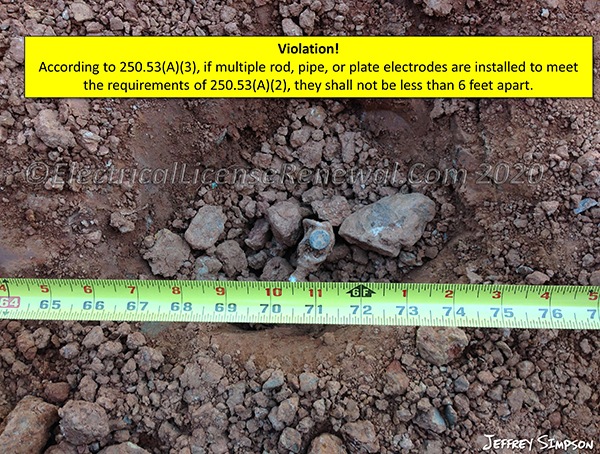250.52 Electrodes Permitted for Grounding.

Section 250.52 provides a list of what items can be used as a grounding electrode. This includes the following:
- Metal Underground Water Pipes under certain conditions
- Metal In-ground Support Structures under certain conditions
- Concrete-Encased Electrodes
- Ground Rings
- Rod and Pipe Electrodes
- Other Listed Electrodes
- Ground Plates
- Other Local Metal Underground Systems or Structures
According to 250.53(A)(2), a single rod, pipe, or plate electrodes needs to be supplemented with an additional electrode unless it can be proven that a single rod, pipe, or plate grounding electrode has a resistance to earth of 25 ohms or less.
According to 250.53(A)(3), if multiple rod, pipe, or plate electrodes are installed to meet the requirements of 250.53(A)(2), they shall not be less than 6 feet apart.
Below is a preview of Article 250. See the actual NEC® text at NFPA.ORG for the complete code section. Once there, click on their link to free access to the 2020 NEC® edition of NFPA 70.
2020 Code Language:
250.52 Grounding Electrodes.
250.52(A) Electrodes Permitted for Grounding.
(1) Metal Underground Water Pipe. A metal underground water pipe in direct contact with the earth for 3.0 m (10 ft) or more (including any metal well casing bonded to the pipe) and electrically continuous (or made electrically continuous by bonding around insulating joints or insulating pipe) to the points of connection of the grounding electrode conductor and the bonding conductor(s) or jumper(s), if installed.
(2) Metal In-ground Support Structure(s). One or more metal in-ground support structure(s) in direct contact with the earth vertically for 3.0 m (10 ft) or more, with or without concrete encasement. If multiple metal in-ground support structures are present at a building or a structure, it shall be permissible to bond only one into the grounding electrode system.
Informational Note: Metal in-ground support structures include, but are not limited to, pilings, casings, and other structural metal.
(3) Concrete-Encased Electrode. A concrete-encased electrode shall consist of at least 6.0 m (20 ft) of either (1) or (2):
(1) One or more bare or zinc galvanized or other electrically conductive coated steel reinforcing bars or rods of not less than 13 mm (1∕ 2 in.) in diameter, installed in one continuous 6.0 m (20 ft) length, or if in multiple pieces connected together by the usual steel tie wires, exothermic welding, welding, or other effective means to create a 6.0 m (20 ft) or greater length; or
(2) Bare copper conductor not smaller than 4 AWG
Metallic components shall be encased by at least 50 mm (2 in.) of concrete and shall be located horizontally within that portion of a concrete foundation or footing that is in direct contact with the earth or within vertical foundations or structural components or members that are in direct contact with the earth. If multiple concrete-encased electrodes are present at a building or structure, it shall be permissible to bond only one into the grounding electrode system.
Informational Note: Concrete installed with insulation, vapor barriers, films or similar items separating the concrete from the earth is not considered to be in “direct contact” with the earth.
(4) Ground Ring. A ground ring encircling the building or structure, in direct contact with the earth, consisting of at least 6.0 m (20 ft) of bare copper conductor not smaller than 2 AWG.
(5) Rod and Pipe Electrodes. Rod and pipe electrodes shall not be less than 2.44 m (8 ft) in length and shall consist of the following materials.
(a) Grounding electrodes of pipe or conduit shall not be smaller than metric designator 21 (trade size 3∕ 4) and, where of steel, shall have the outer surface galvanized or otherwise metal-coated for corrosion protection.
(b) Rod-type grounding electrodes of stainless steel and copper or zinc coated steel shall be at least 15.87 mm (5∕ 8 in.) in diameter, unless listed.
(6) Other Listed Electrodes. Other listed grounding electrodes shall be permitted.
(7) Plate Electrodes. Each plate electrode shall expose not less than 0.186 m2 (2 ft2) of surface to exterior soil. Electrodes of bare or electrically conductive coated iron or steel plates shall be at least 6.4 mm (1∕ 4 in.) in thickness. Solid, uncoated electrodes of nonferrous metal shall be at least 1.5 mm (0.06 in.) in thickness.
(8) Other Local Metal Underground Systems or Structures. Other local metal underground systems or structures such as piping systems, underground tanks, and underground metal well casings that are not bonded to a metal water pipe.